Ce site n'est pas supporté par votre navigateur actuel.
Veuillez utiliser un des navigateurs si dessous.
Biogas Plant Development Handbook
VERSION FRANÇAISE ACTUELLEMENT EN TRADUCTION
The objectives of this handbook are to provide the reader with a general project development roadmap to assist him/her through the complex tasks of planning, designing, procuring, permitting, building and operating an efficient and viable biogas plant.
Note that this handbook will be regularly updated with new content about biogas, anaerobic digestion, and the best practices of our industry.
Biogas plant development handbook
Foreword
Our firm has been selling biogas engineering expertise for over 12 years in various agricultural, agro-food and municipal organic waste management sectors. I’m constantly amazed to discover that significant biogas plant projects suffer from improper planning and design resulting in suboptimal biogas plants operation and economics. Most of these easily avoidable errors are due to initial misconception, lack of knowledge and information on the subject of biogas plant engineering.
There exist a lot of excellent publications on the subject of anaerobic digestion and biogas utilization but very few on the subject of biogas engineering and biogas project development as a whole.
I remember my early years as a biogas engineer where I got infatuated with the subject and devoured a large quantity of technical information on anaerobic digestion and biogas utilization. Over the years, these technical aspects have receded to the background as I focused my work on equally complex issues such as project planning, financing, procurement, permitting, politics and operation. It is these subject matters that are the primary focus of this handbook.
This handbook has been written to be published as either a set of ever-evolving hyperlinked articles in a website (BiogasWorld) or as a standalone eBook because the rapidly evolving biogas industry demands it.
I hope you will enjoy the reading and find valuable information to help you design, build, and operate a better biogas plant.
Eric Camirand, P.Eng.
President, Electrigaz Technologies Inc.
Introduction
This handbook has been written for readers recognizing themselves in one of these statements:
- You are asking yourself how you could turn organic waste into gold?
- You have been tasked with the job of building a biogas plant to treat organic waste and have no clue how to go about it?
- You have been studying this subject for years and you think you are now ready to build your own biogas plant?
- You are intrigued by this amazing technology converting waste into renewable energy and fertilizer and want to learn more about it?
- You have been learning about biogas for years and the more you learn about it the more you realize its complexity and get confused?
- You are operating a biogas plant and are wondering why it is performing poorly and trying to find concrete solutions to these problems?
If you identified yourself in one of these statements, you are officially deemed cursed with an infinite appetite for more information on the subject matter of biogas plant development and operation.
This handbook has been written to help you make the best out of your predicament.
Why building biogas plants?
Why would you not want to get rich by turning organic waste into renewable energy and fertilizer while reducing overall environmental issues related to their disposal?
In reality, there exist three (3) reasons why people build biogas plants:
- Compliance with regulation
- Economic opportunities
- Madness
Beyond this reality, there exists a killer question that is frequently asked: “Why not compost? Isn’t it less expensive?”
The easy answer is: “It depends.” (given, not a very useful answer). In reality, it is difficult to answer this question simply. Each project has its own regulatory, energy market and local environmental realities that influence the choice between composting or anaerobic digestion.
In general, it is cheaper to perform open air composting at smaller solid organic waste tonnages (less than 10 000 tonnes/year). Beyond that, a thorough feasibility study must be performed to measure the challenges and opportunities of each organic waste treatment technology.
Anaerobic digestion and composting are often played one against the other. In reality, these technologies are complementary and should often be developed jointly to leverage the strengths that each has to offer.
Regulatory
There are three (3) major regulatory drivers forcing the development of biogas plants:
- Greenhouse gas (GHG) policies
- Renewable energy policies
- Recycling policies
Despite their biogas capture systems, landfill emits a significant amount of fugitive methane to the atmosphere, therefore contributing to greenhouse gas emissions. Additionally, landfilling of organics does not comply with typical recycling policies that state that waste should be reduced, reused and recycled (3Rs) prior to final disposal, since organic waste in this scenario is not returned to land.
For these reasons, GHG and recycling policies are generally leading to the ban of organic landfilling therefore forcing composting and/or anaerobic digestion of organic waste.
Renewable energy policies such as Renewable Portfolio Standards (RPS) established in many states and countries force energy utilities to produce a certain percentage of their energy from renewable sources. These utilities are constantly on the lookout for affordable renewable energy such as biogas energy.
Economic opportunity
Biogas plants create economic opportunities in markets where energy cost and/or waste disposal cost are relatively high. Since the organic fraction of municipal solid waste can represent approximately 50% of MSW mass, it becomes economically interesting to divert the organic fraction from conventional disposal towards anaerobic digestion.
Processing of organic waste in a biogas plant can help save waste disposal cost. Production of biogas from organic waste can help generate an affordable renewable energy. Combined, these opportunities drive the development of biogas projects.
For example, small insular countries can benefit greatly from biogas plant since they often generate expensive and dirty electricity with diesel ($0.50+/kWh) and are confronted with significant challenges regarding disposal of their waste.
Madness
Some biogas plants get built for no good reasons, primarily driven by sheer madness and/or egotistical motivations. Most of these project developers were blind to key biogas project fundamentals that will be discussed later in this handbook.
These poorly planned and executed projects are resulting in biogas plants with poor operational and economic efficiencies and in general hurt the industry.
Anaerobic digestion
Anaerobic digestion is a natural bacterial process by which a consortium of anaerobic bacteria is biodegrading organic matter in an environment without oxygen.
These bacteria require a favorable environment to thrive. Proper temperature, lack of oxygen, proper feeding, acidity, and mixing are the key to efficient anaerobic digestion.
The anaerobic digestion process takes place into equipment called anaerobic digesters or in short, digesters. Digesters must be fed as constantly as possible regardless of feedstock fluctuations.
Several types of bacteria work together to convert the digestible volatile solids within the feedstock into biogas. Though most feedstocks are composed primarily of water, you cannot make biogas out of water. You make biogas out of the digestible fraction of the solids within the feedstock.
Although lignocellulosic material, such as wood, contains a lot of volatile solids (burnable), these solids are not digestible in an anaerobic digester.
The conversion of solids into biogas has for effect to make the substrate more liquid. That’s why it is possible to feed solid feedstock into liquid digesters without them clogging up.
Biogas is composed primarily of methane and carbon dioxide.
Biogas plant fundamentals
Inexperienced biogas developers often focus their effort on the technical aspects rather than the project fundamentals.
The technology choice is always secondary to the establishment of the following fundamentals:
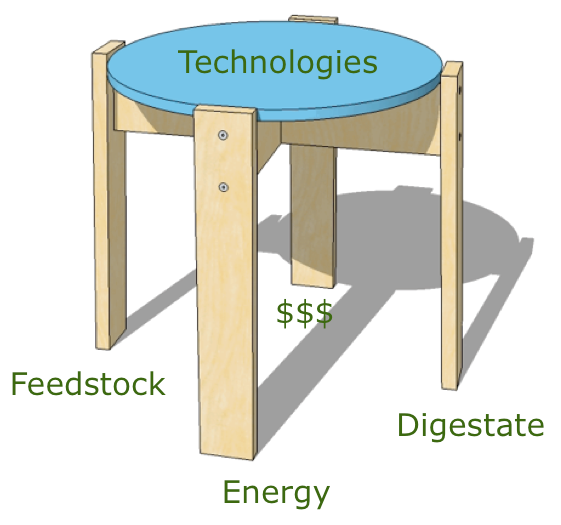
The feedstock quantity and composition must be well known and under the control of the project developer. Without proper feedstock, there is no biogas project.
There must be a client for the biogas energy. If there is none, might as well just compost the material.
Biogas plants transform only 10% of the mass they process into biogas. The remaining 90% of the mass fed into the digester comes out as a fertilizer called digestate. The project must have a long term inexpensive outlet for this digestate otherwise the project will not succeed.
Finally, the project must be bankable. That means that investment, operational costs, and revenue must be predictable and balanced for the project to secure its financing.
If any of these fundamentals fall short the table will tilt and will make the project viability difficult or impossible. The technology choice is a result of these fundamentals.
Biogas plant safety
Biogas plant accidents happen and people get hurt or die. Not only do these accidents hurt people but they also set back the biogas industry as a whole. It is important that biogas plant designers, builders, operators and general public safety become an integral value of any biogas plant development.
Designers and operators must work hand in hand to identify health and safety risks and take actions to mitigate them.
Biogas plant health and safety risks are:
- Fire
- Explosion
- Gas poisoning (H2S, NH3)
- High pressure
- Gas or liquid leaks
- Rotating mechanical equipment
- Pathogens (diseases)
All these risks are easily mitigated if safety is engraved within the DNA of the project.
Input feedstock
The feedstock dictates the biogas technology to be used, not the other way around. In order to properly design a biogas plant, the developer must fully understand its feedstock.
How will the feedstock be collected and arrive at the biogas plant? How much of it? When will it come? Which form, liquid or solid? Which type of trucks? Is there a significant variation in volumes throughout the seasons? Will this volume increase or decrease over the years?
A significant amount of work must go into trying to model the variation of feedstock throughout the days, months and years of a project. Without this information, it is likely to lead to improper sizing of biogas plants resulting in an inefficient operation and investment.
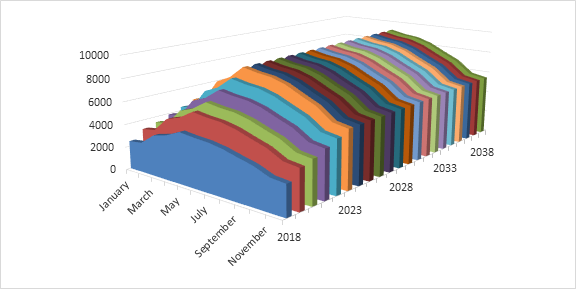
The composition of the feedstock must also be well known to identify the most suitable technologies to process this material. Furthermore understanding feedstock composition will allow forecasting digestate quality which will help identify outlets for the digestate.
A detailed analysis of the feedstock composition from a trusted laboratory will outline the following feedstock properties:
- Dry matter content or total solids (TS)
- Volatile solids (VS)
- Total Kedjhal Nitrogen (TKN)
- pH
- Alkalinity
- Contaminants (plastics, glass, metals, etc.)
The total solids test consists of completely drying the material to determine the mass ratio of solids versus the water in the material. For example, dairy cow slurry typically contains 10% solids and 90% water.
The volatile solids test consists of burning (600 °C) the solids from the total solids test to determine the mass ratio of volatile solids (burned) versus ashes.
Note that lignocellulosic material (wood) and plastics will volatilize but are in fact not digestible by anaerobic digesters.
Furthermore, anaerobic digestion may be hindered by various inhibiting compounds such as sulphur, salts, ammonia, etc.
For these reasons, additional tests may be performed on the feedstock to determine digestibility, long-term stability and biogas yield. Laboratories with biogas expertise will offer the following tests:
- Biomethane Potential (BMP)
- Anaerobic Toxicity Assay (ATA)
- Continuous Digestion
Biogas process technologies
Anaerobic digestion processing technologies are divided into two major families:
- Wet digestion
- Dry digestion
In either case, these technologies offer either batch or continuous processes.
Wet digestion
The process is considered wet digestion when the content of the digester is pumpable. That means that the material inside the digester has a consistency of approximately 10% dry matter or less (90% water).
There exist many configurations of wet digesters:
- Complete mix or Completely stirred tank reactor (CSTR)
- Plug-flow
- Upflow Anaerobic Sludge Blanket (UASB)
- Fixed film reactor
- Floating films reactors
- Sludge bed reactors
- And more.
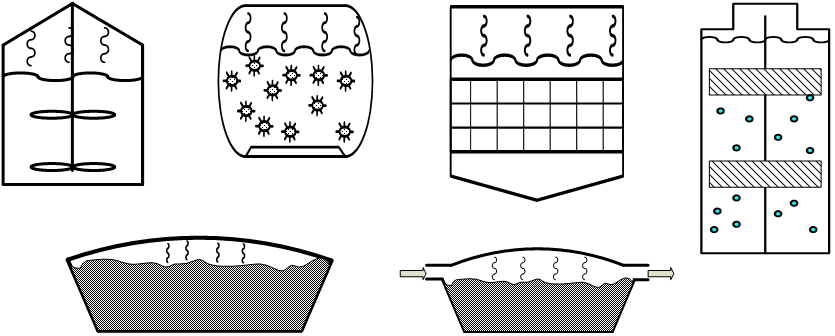
These configurations have been designed to optimize the process for various feedstock conditions and market applications.
The mass balance of a typical wet digestion process looks like this:
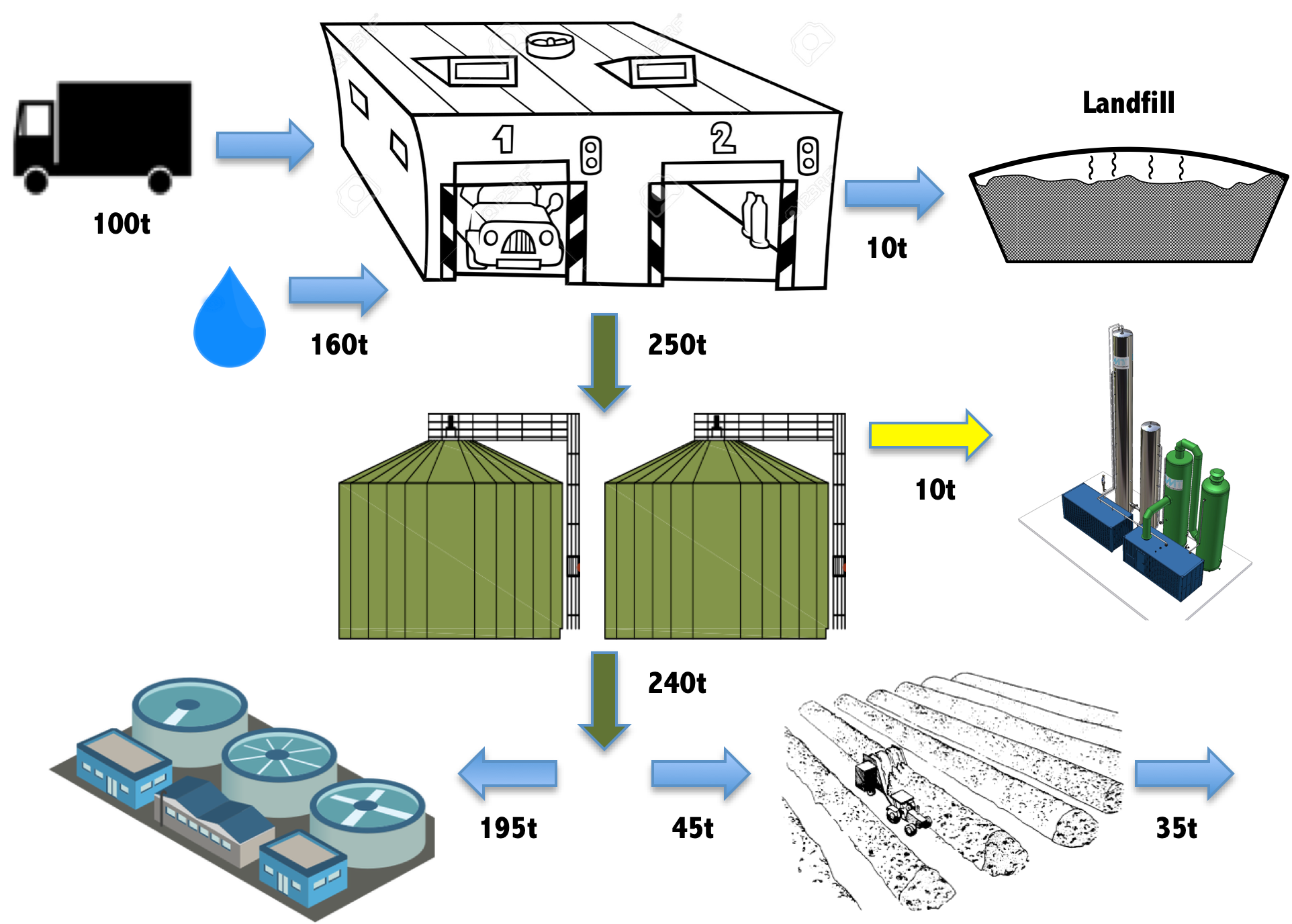
For example, 100 tonnes of solid municipal residential source separated organics (SSO) arrives at the wet, complete mix, biogas plant. This feedstock needs to be pretreated to remove potential contaminants (plastics, metal, sands, etc.). Approximately 10 tonnes will be removed as contaminants and will probably be landfilled.
In order to be pumpable (10% TS), the feedstock will be diluted with water that may come from a fresh source or from a mixed of fresh and recycled water from the wastewater portion of the biogas plant. The liquid feedstock going to the digester will be approximately 250 tonnes.
In the digesters, the bacteria will consume the majority of the volatile solids in the feedstock and will convert them into biogas. Approximately 10 tonnes of gas will come out of the digesters. The more liquid digestate will represent approximately 240 tonnes.
At this point, the digestate may be applied to land directly. Please note that 100 tonnes of solid material turned into 240 tonnes of liquid and land applying the digestate in this form will present significant transportation costs.
The digestate may also be separated into a solid fraction (45 tonnes) to be land applied (or composted down to 35 tonnes) and a liquid fraction (195 tonnes) to be returned the sanitary sewage or directly back to nature.
One may be tempted to use the treated wastewater as dilution water for the input feedstock and limit the amount of water consumed and rejected by the process. It is possible only if the wastewater plant removes almost all nutrients (salts and ammonia/ammonium) in the water. Without this removal, there will be a rapid build up of nutrients in the water and this will inhibit and/or kill the anaerobic digestion process.
Dry digestion
The process is considered dry digestion when the content of the digester is not pumpable. That means that the material inside the digester has a consistency of approximately 10% dry matter or more.
There exist many configurations of dry digesters:
- Continuous vertical
- Continuous horizontal
- Batch (Garages)
- And more.
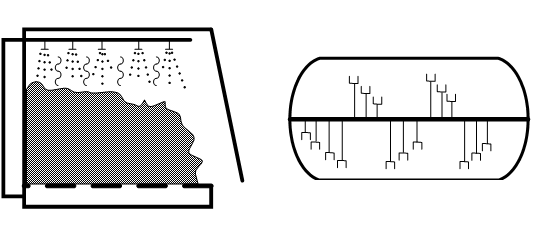
These configurations have been designed to optimize the process for various feedstock conditions and market applications.
The mass balance of a typical dry digestion process
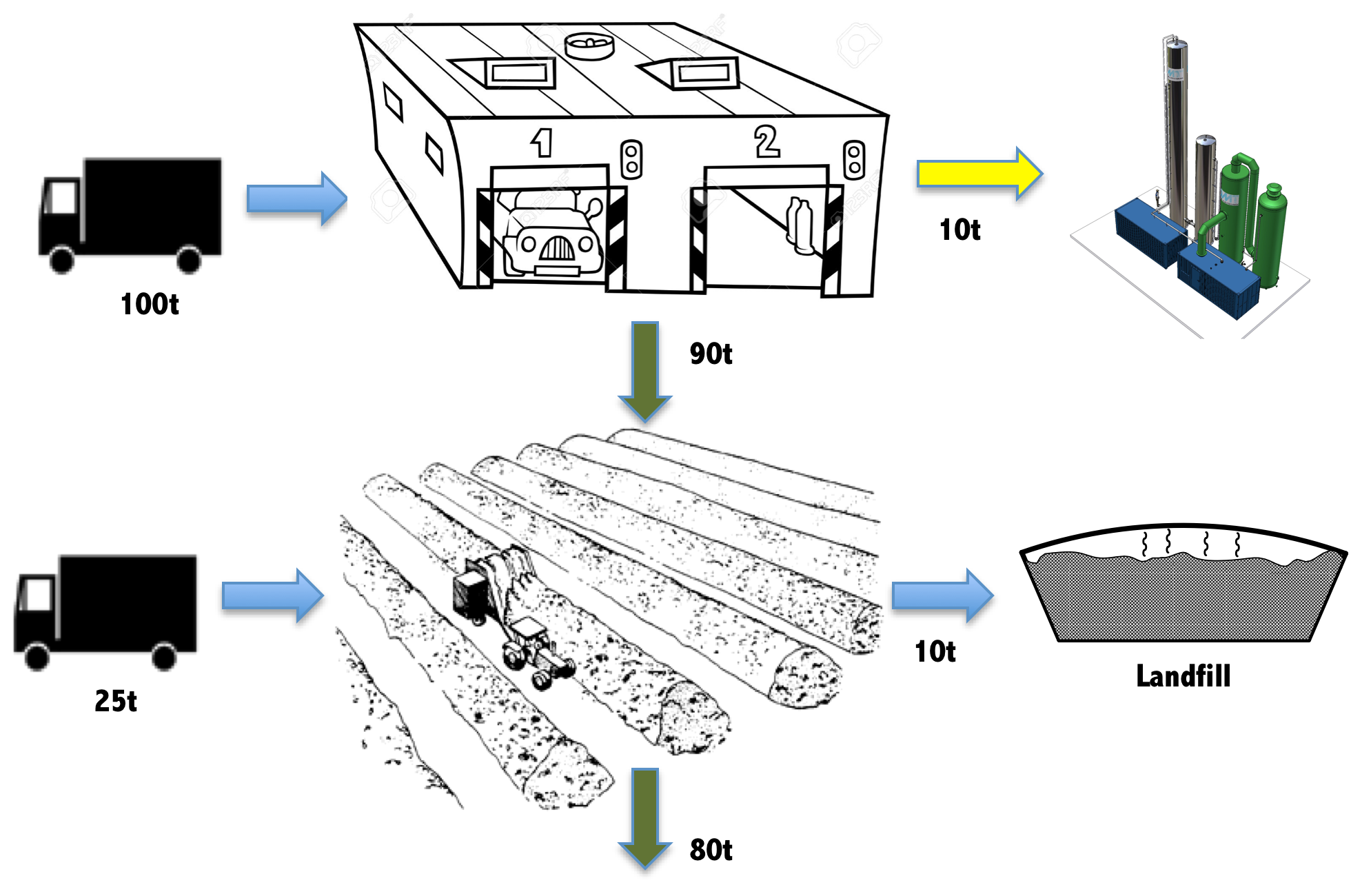
For example, 100 tonnes of solid municipal residential source separated organics (SSO) arrives at the dry, garage style, biogas plant. This feedstock does not need to be pretreated to remove potential contaminants (plastics, metal, sands, etc.).
In the digesters, the bacteria will consume the majority of the volatile solids in the feedstock and will convert them into biogas. Approximately 10 tonnes of gas will come out of the digesters. The solid digestate will represent approximately 90 tonnes. Note that the digestate coming out will be more liquid than the incoming material. In some case, it may be necessary to add bulking agent prior to digestion to ensure the out coming material remains solid.
In certain continuous “dry” digesters the material can come out as a thick liquid. In these instances, this liquid is still contaminated with (plastics, metals, rock, sands, etc.) and is very difficult material to recycle to land.
In our example, the solid digestate cannot be applied to land directly because the contaminants have not yet been removed. In order to remove the contaminants, the material will have to be dried enough to allow sieving without clogging the screens.
The most efficient way to dry this material is to compost it with drier material such a garden waste. Compost is a science of its own and will not be discussed here. However, we will mention that composting often required a bulking agent (25 tonnes) to ensure proper material structure complying with aerobic composting conditions. The bulking agent will be added to the tonnage of material to be sieved to achieve recycle to land quality.
The digestate may also be separated into a solid fraction (45 tonnes) to be land applied, and a liquid fraction (195 tonnes) to be returned the sanitary sewage or directly back to nature.
Here also, one may be tempted to use the treated wastewater as dilution water for the input feedstock and limit the amount of water consumed and rejected by the process. It is possible only if the wastewater plant removes almost all nutrients (salts and ammonia/ammonium) in the water. Without this removal, there will be a rapid build up of nutrients in the water and this will inhibit and/or kill the anaerobic digestion process.
Wet versus Dry digestion
As illustrated in the examples above, there is no silver bullet, and it is not true that dry digestion resolves all wastewater issues since composting plants have leachate treatment challenges of their own.
In the example above, by using the wet digestion process, it resulted in 100 tonnes of SSO being converted into 45 tonnes of solid digestate and approximately 100 tonnes of wastewater (some recycled). By using the dry digestion process it resulted in 80 tonnes of compost recycled to land but having to operate a composting plant of equal size to the biogas plant.
In general, if there exist wastewater capacity capable of removing ammonia the wet digestion is favoured, and if there exist composting capacity the dry digestion is favoured.
In short, do your homework and don’t drink the salesman Kool-Aid.
Biogas energy
Biogas is a versatile renewable energy that can be used into direct thermal, electrical and to displace natural gas in thermal or vehicular applications.
Biogas from properly functioning anaerobic digestion system is typically composed of:
- Methane (55-65%)
- Carbon dioxide (35-45%)
- H2S (100-10000 PPM)
- Water vapor (saturated at biogas temperature)
- Ammonia (traces)
Like biogas, natural gas is composed primarily of methane. Biogas is like wet natural gas diluted with carbon dioxide and other corrosive gases. Biogas from landfills will have less methane in proportion because air (nitrogen & oxygen) gets inhaled into the biogas collection system.
Biogas utilisation
Each biogas application requires specific biogas conditioning and conversion equipment.
Renewable Natural Gas (RNG) or biomethane
There exist several technologies that allow for cleaning or upgrading the biogas into a renewable natural gas of quality suitable for injection into the gas grid.
These technologies are:
- Water wash
- Membranes
- Adsorption or PSA
- Absorption or Organic solvent dilution
- Others
These technologies allow for removal of carbon dioxide (CO2) and other impurities (H2O, N2, H2S, siloxanes, etc.) so that that the biomethane becomes interchangeable with conventional natural gas and can be injected safely into gas pipelines. Typically these technologies will capture approximately 90+% of the methane in the biogas (loss of 10% of less) and will bring biomethane or renewable natural gas quality to 97+% CH4.
Combined Heat and Power (CHP)
In this application biogas is cleaned up to remove primarily H2S, siloxanes, and water vapor prior to being fed into an internal combustion engine (ICE) or a micro-turbine. The engine or turbine turns an electrical generator producing electricity that is injected into the electrical grid via a set of electrical protections and transformers.
In the process, the engine generates a lot of heat. Heat recovery units are added to the engine to recover exhaust gas heat and engine cooling heat to generate hot water or low-pressure steam.
Typically, a biogas CHP will convert 40% of the biogas energy into electricity, and 50% into hot water.
CHP have a typical capacity factor of 95% which means that they produce electricity steadily throughout the year (8300+ hrs/yr) which makes them a reliable energy production asset.
Direct thermal (boiler or furnace)
In this application, biogas may be cleaned or not (depending on H2S or siloxanes) and fed into a boiler to make hot water or steam for industrial applications. Boiler efficiency can be as high as 95% so almost all the biogas energy gets converted into useful energy (hot water, steam or hot air).
However, natural gas equipment must be converted in order to burn efficiently biogas since biogas has less energy because it contains 40% CO2, which is not a fuel.
Note that a boiler connected to a biogas plant will produce heat 24/7 and will require a heat client with similar energy profile needs, otherwise energy will be wasted.
Natural gas vehicle (NGV) applications
Biogas cannot be used directly into compressed natural gas vehicles. Because of its corrosive components, biogas will compromise the safety of the high pressure cylinders. However, if biogas is converted to RNG or biomethane as described above, it can thereafter be used to fill up natural gas vehicles.
Typically the biogas plant will inject its biomethane into the grid and the NGV compression station will be built somewhere along the grid. In this scenario, the grid acts as a buffer because the filling cycles are unlikely to match the steady production of a biogas plant.
Biogas production versus consumption
Stable anaerobic digestion process will produce biogas steadily 24 hours per day, 365 days per year without any interruption.
The biogas energy clients must have a similar consumption profile or must provide a buffering capacity to absorb the differences between the production and consumption.
Biogas storage
Biogas is typically stored at near atmospheric pressure. Since biogas in its raw form is wet and corrosive, it cannot be stored in pressure vessels because it will cause corrosion leading to safety issues.
Pressure storage is possible only if the biogas has been upgraded to renewable natural gas pipeline specifications.
Storage at atmospheric pressure takes up a lot of volume.
Digestate management
As illustrated in the article about Wet Versus Dry Digestion, there exist essentially five (5) types of digestate
- Clean liquid digestate
- Clean solid digestate
- Contaminated liquid digestate
- Contaminated solid digestate
- Contaminated semi-solid digestate
Only the clean liquid or solid digestates can be directly applied to land without further treatment. These digestates often originate from manure, food waste or pre-treated SSO digesters where there are virtually no contaminants in the feedstock to be digested.
Most of the time, liquid digestate is separated into a solid and a liquid fractions by using liquid/solid separation technologies.
Solid fraction
As mentioned earlier, clean solid digestate can be applied to land directly.
Contaminated solids coming from a dry digester or a liquid/solid separation equipment will need to be composted to achieve proper dryness for the sieving of contaminants prior to land application.
Liquid fraction
Also mentioned earlier, clean liquid digestate can be applied to land directly.
Contaminated liquids coming from a wet digester or a liquid/solid separation equipment will require proper wastewater treatment such as sedimentation of suspended solids, abatement of COD, BOD and ammonia compounds.
Biogas plant components
Site
Several aspects need to be studied in the choice of a site:
- Dominant wind/Air dispersion
- Road access
- Proximity to energy grids
- Geotechnical
- Contamination
- Proximity of neighbours
Civil work
The biogas plant will be equipped with roads, scale, drainage, landscaping, etc.
Buildings
Biogas plants will have one or more building(s) to contain the process and all the human resources operating and maintaining it. These building may require special architectural specifications for aesthetic, comfort and efficiency.
Reception
This is the area of the biogas plant where the feedstock is received. It may be designed to receive several trucks of various sizes. Typically, the reception of material will be indoor and this is where most of the odour challenges arise. Opening and closing of doors for trucks is typically the main source of odours for a biogas plant.
Feedstock conditioning
Depending on the technologies used, this is where the received material is prepared for feeding into digesters. It may be decontaminated by using technologies such as:
- Hydropulpers
- Separating hammermills
- Presses
Anaerobic digestion
Central equipment of a biogas plant, the digester is where feedstock is biodegraded by anaerobic bacterias to generate the biogas and digestate.
Digestate treatment
Separation : The liquid digestate may be squeezed to separate the liquid fraction from the solids.
Composting : A biogas plant may be equipped with a composting plant to stabilize or allow the drying and decontamination of the solid fraction of its digestate.
Wastewater treatment: The liquid fraction of the digestate often needs to be treated prior to disposal into nature or into sewage.
Odour treatment
Odours generated inside the building need to be controlled (with proper ventilation) and treated prior to rejection into the atmosphere.
Biogas handling
All the equipment necessary to handle the biogas such as:
- Pipes
- Flowmeters
- Condensate traps
- Storage
- Flare
Biogas treatment
Equipment necessary to clean the biogas to the proper specifications for the intended application.
Biogas utilisation
Equipment that will allow utilisation of the biogas or biomethane (RNG):
- Boiler
- CHP
- Biogas upgrader
- Compressor
Biogas project economics
Biogas plant economics are complex and vary with local market conditions.
Revenue
Biogas plants can generate several revenues such as:
- Treatment fees: Money you receive (or save) for accepting and treating the feedstock. In North America, this represents the majority of the income of the project (60-80%).
- Energy sales: Money you receive for selling the biogas energy (20-40% of income). Only in markets with generous feed-in-tariffs will the energy be the majority of the project income.
- Digestate/compost sales: Money you receive (or save) for selling your digestate or compost. Typically, you have to pay to dispose of the digestate or compost.
- Carbon credits: Biogas plants do generate carbon credits that can be sold. However, the volume is small and the validation and certification fees often take the lion’s share of this income.
Financing
Biogas plants are financed using equity, debt, subsidies and tax credits. Municipalities will finance their project with subsidies and debt. Private projects will require significant equity (25%) and energy contracts from solid clients to secure their debt.
OPEX
Operational expenses (OPEX) are typically composed of:
- Salaries
- Debt service charges
- Disposal charges (contaminants, digestate)
- Energy (consumed)
- Equipment maintenance
- Consumables
- Taxes
- Insurances
CAPEX
Capital expenses (CAPEX) vary greatly between projects.
Municipal projects are the most complex and expensive. Typically in North America they cost anywhere between $800-$1500/tonne of annual treatment capacity.
Agricultural projects are the simplest and least expensive. Typically in North America they cost anywhere between $4500-8000/kW electrical installed.
Biogas project development
There exist several steps to the realisation of a biogas project.
Studies and preliminary engineering
A lot of work needs to go into establishing the project fundamentals (studies). Once the fundamentals are established, a concept needs to be drawn and priced in order to get a project budget. Proper preliminary engineering is essential to align the financing and get the first tranche to fund design.
Design
Detailed engineering is performed to generate drawings and specifications of all the components of the biogas plant. The design must comply with local codes and regulations.
Permitting & energy contracting
Getting all the approvals to build the plant from the authorities. Sign an energy contract with a client.
Financing
The bulk of financing will only occur if the project is permitted and if there is a solid client for the biogas energy.
Procurement
Purchasing the products and services to realise the design.
Construction
Building of the design.
Commissioning
Beginning of the various processes, corrections, and modifications to achieve process performances. Documentation and training of operators. The end of the commissioning is the acceptance of the plant for operation.
Operation
Day to day operation of the biogas plant includes the following tasks:
- Reception of material
- Conditioning of material
- Anaerobic digestion process control
- Operation of digestate treatment system
- Operation of wastewater process
- Disposal of contaminants
- Operation of composting process (if there is)
- Disposal of digestate/compost
Maintenance
Maintenance of the equipment to ensure proper functioning throughout the entire planned life cycle.
Optimization
Modifications to the biogas plant to achieve improved performance.
Afterword
Nowadays, online documents are constant work in progress that can be re-edited at a click of a button. In this new world, the concept of afterword is somehow obsolete. However, I would like to say that writing the first version of this handbook has procured me a lot of satisfaction and I hope I will derive the same feeling trying to make it progress over time to make it become a work of reference used by all getting on the trail to the development of a productive biogas plant.

